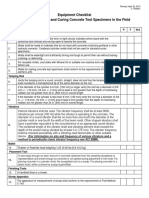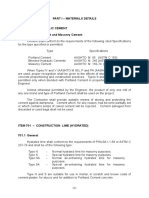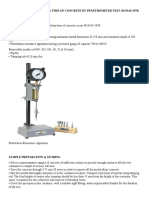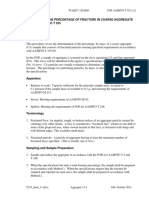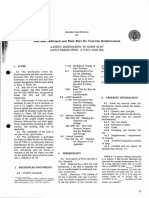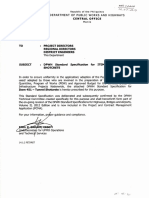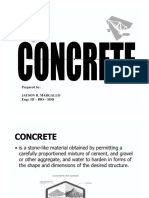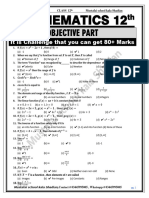Method of Making and Curing Concrete Test Specimens in The Field Fop For Aashto T 23 Scope
Uploaded by
mohamed samirMethod of Making and Curing Concrete Test Specimens in The Field Fop For Aashto T 23 Scope
Uploaded by
mohamed samirCONCRETE WAQTC FOP AASHTO T 23 (18)
METHOD OF MAKING AND CURING CONCRETE TEST SPECIMENS IN THE
FIELD
FOP FOR AASHTO T 23
Scope
This procedure covers the method for making, initially curing, and transporting concrete test
specimens in the field in accordance with AASHTO T 23-18.
Warning—Fresh Hydraulic cementitious mixtures are caustic and may cause chemical burns
to skin and tissue upon prolonged exposure.
Apparatus
• Concrete cylinder molds: Conforming to AASHTO M 205 with a length equal to
twice the diameter. Standard specimens shall be 150 mm (6 in.) by 300 mm (12 in.)
cylinders. Mold diameter must be at least three times the maximum aggregate size
unless wet sieving is conducted according to the FOP for WAQTC TM 2. Agency
specifications may allow cylinder molds of 100 mm (4 in.) by 200 mm (8 in.) when
the nominal maximum aggregate size does not exceed 25 mm (1 in.).
• Beam molds: Rectangular in shape with ends and sides at right angles to each other.
Must be sufficiently rigid to resist warpage. Surfaces must be smooth. Molds shall
produce length no more than 1.6 mm (1/16 in.) shorter than that required (greater
length is allowed). Maximum variation from nominal cross section shall not exceed
3.2 mm (1/8 in.). Ratio of width to depth may not exceed 1:5; the smaller dimension
must be at least 3 times the maximum aggregate size. Standard beam molds shall
result in specimens having width and depth of not less than 150 mm (6 in.). Agency
specifications may allow beam molds of 100 mm (4 in.) by 100 mm (4 in.) when the
nominal maximum aggregate size does not exceed 38 mm (1.5 in.). Specimens shall
be cast and hardened with the long axes horizontal.
• Standard tamping rod: 16 mm (5/8 in.) in diameter and 400 mm (16 in.) to 600 mm
(24 in.) long, having a hemispherical tip of the same diameter as the rod for preparing
150 mm (6 in.) x 300 mm (12 in.) cylinders.
• Small tamping rod: 10 mm (3/8 in.) diameter and 305 mm (12 in.) to 600 mm (24 in.)
long, having a hemispherical tip of the same diameter as the rod for preparing 100
mm (4 in.) x 200 mm (8 in.) cylinders.
• Vibrator: At least 9000 vibrations per minute, with a diameter no more than ¼ the
diameter or width of the mold and at least 75 mm (3 in.) longer than the section being
vibrated for use with low slump concrete.
• Scoop: a receptacle of appropriate size so that each representative increment of the
concrete sample can be placed in the container without spillage.
• Trowel or float
41_T23_short_18 Concrete 14-1 Pub. October 2019
CONCRETE WAQTC FOP AASHTO T 23 (18)
• Mallet: With a rubber or rawhide head having a mass of 0.57 ±0.23 kg
(1.25 ±0.5 lb.).
• Rigid base plates and cover plates: may be metal, glass, or plywood.
• Initial curing facilities: Temperature-controlled curing box or enclosure capable of
maintaining the required range of 16 to 27°C (60 to 80°F) during the entire initial
curing period (for concrete with compressive strength of 40 Mpa (6000 psi) or more,
the temperature shall be 20 to 26°C (68 to 78°F). As an alternative, sand or earth for
initial cylinder protection may be used provided that the required temperature range is
maintained, and the specimens are not damaged.
• Thermometer: Capable of registering both maximum and minimum temperatures
during the initial cure.
Procedure – Making Specimens – General
1. Obtain the sample according to the FOP for WAQTC TM 2.
2. Wet Sieving per the FOP for WAQTC TM 2 is required for 150 mm (6 in.) diameter
specimens containing aggregate with a nominal maximum size greater than 50 mm
(2 in.); screen the sample over the 50 mm (2 in.) sieve.
3. Remix the sample after transporting to testing location.
4. Begin making specimens within 15 minutes of obtaining the sample.
5. Set molds upright on a level, rigid base in a location free from vibration and relatively
close to where they will be stored.
6. Fill molds in the required number of layers, attempting to slightly overfill the mold on
the final layer. Add or remove concrete before completion of consolidation to avoid a
deficiency or excess of concrete.
7. There are two methods of consolidating the concrete – rodding and internal vibration.
If the slump is greater than 25 mm (1 in.), consolidation may be by rodding or
vibration. When the slump is 25 mm (1 in.) or less, consolidate the sample by
internal vibration. Agency specifications may dictate when rodding or vibration will
be used.
Procedure – Making Cylinders –Self-Consolidating Concrete
1. Use the scoop to slightly overfill the mold. Evenly distribute the concrete in a
circular motion around the inner perimeter of the mold.
2. Strike off the surface of the molds with tamping rod, straightedge, float, or trowel.
3. Immediately begin initial curing.
41_T23_short_18 Concrete 14-2 Pub. October 2019
CONCRETE WAQTC FOP AASHTO T 23 (18)
Procedure – Making Cylinders – Rodding
1. For the standard 150 mm (6 in.) by 300 mm (12 in.) specimen, fill each mold in three
approximately equal layers, moving the scoop or trowel around the perimeter of the
mold to evenly distribute the concrete. For the 100 mm (4 in.) by 200 mm (8 in.)
specimen, fill the mold in two layers. When filling the final layer, slightly overfill the
mold.
2. Consolidate each layer with 25 strokes of the appropriate tamping rod, using the
rounded end. Distribute strokes evenly over the cross section of the concrete. Rod the
first layer throughout its depth without forcibly hitting the bottom. For subsequent
layers, rod the layer throughout its depth penetrating approximately 25 mm (1 in.)
into the underlying layer.
3. After rodding each layer, tap the sides of each mold 10 to 15 times with the mallet
(reusable steel molds) or lightly with the open hand (single-use light-gauge molds).
4. Strike off the surface of the molds with tamping rod, straightedge, float, or trowel.
5. Immediately begin initial curing.
Procedure – Making Cylinders – Internal Vibration
1. Fill the mold in two layers.
2. Insert the vibrator at the required number of different points for each layer (two points
for 150 mm (6 in.) diameter cylinders; one point for 100 mm (4 in.) diameter
cylinders). When vibrating the bottom layer, do not let the vibrator touch the bottom
or sides of the mold. When vibrating the top layer, the vibrator shall penetrate into
the underlying layer approximately 25 mm (1 in.)
3. Remove the vibrator slowly, so that no large air pockets are left in the material.
Note 1: Continue vibration only long enough to achieve proper consolidation of the concrete. Over
vibration may cause segregation and loss of appreciable quantities of intentionally entrained air.
4. After vibrating each layer, tap the sides of each mold 10 to 15 times with the mallet
(reusable steel molds) or lightly with the open hand (single-use light-gauge molds).
5. Strike off the surface of the molds with tamping rod, straightedge, float, or trowel.
6. Immediately begin initial curing.
Procedure – Making Flexural Beams – Rodding
1. Fill the mold in two approximately equal layers with the second layer slightly
overfilling the mold.
2. Consolidate each layer with the tamping rod once for every 1300 mm2 (2 in2) using
the rounded end. Rod each layer throughout its depth, taking care to not forcibly
strike the bottom of the mold when compacting the first layer. Rod the second layer
throughout its depth, penetrating approximately 25 mm (1 in.) into the lower layer.
41_T23_short_18 Concrete 14-3 Pub. October 2019
CONCRETE WAQTC FOP AASHTO T 23 (18)
3. After rodding each layer, strike the mold 10 to 15 times with the mallet and spade
along the sides and end using a trowel.
4. Strike off the surface of the molds with tamping rod, straightedge, float, or trowel.
5. Immediately begin initial curing.
Procedure – Making Flexural Beams – Vibration
1. Fill the mold to overflowing in one layer.
2. Consolidate the concrete by inserting the vibrator vertically along the centerline at
intervals not exceeding 150 mm (6 in.). Take care to not over-vibrate and withdraw
the vibrator slowly to avoid large voids. Do not contact the bottom or sides of the
mold with the vibrator.
3. After vibrating, strike the mold 10 to 15 times with the mallet.
4. Strike off the surface of the molds with tamping rod, straightedge, float, or trowel.
5. Immediately begin initial curing.
Procedure – Initial Curing
• When moving cylinder specimens made with single use molds support the bottom of
the mold with trowel, hand, or other device.
• For initial curing of cylinders, there are two methods, use of which depends on the
agency. In both methods, the curing place must be firm, within ¼ in. of a level
surface, and free from vibrations or other disturbances.
• Maintain initial curing temperature:
- 16 to 27°C (60 to 80°F) for concrete with design strength up to 40 Mpa
(6000 psi).
- 20 to 26°C (68 to 78°F) for concrete with design strength of 40 Mpa
(6000 psi) or more.
• Prevent loss of moisture.
Method 1 – Initial cure in a temperature-controlled chest-type curing box
1. Finish the cylinder using the tamping rod, straightedge, float, or trowel. The finished
surface shall be flat with no projections or depressions greater than 3.2 mm (1/8 in.).
2. Place the mold in the curing box. When lifting light-gauge molds be careful to avoid
distortion (support the bottom, avoid squeezing the sides).
3. Place the lid on the mold to prevent moisture loss.
4. Mark the necessary identification data on the cylinder mold and lid.
41_T23_short_18 Concrete 14-4 Pub. October 2019
CONCRETE WAQTC FOP AASHTO T 23 (18)
Method 2 – Initial cure by burying in earth or by using a curing box over the cylinder
Note 2: This procedure may not be the preferred method of initial curing due to problems in maintaining
the required range of temperature.
1. Move the cylinder with excess concrete to the initial curing location.
2. Mark the necessary identification data on the cylinder mold and lid.
3. Place the cylinder on level sand or earth, or on a board, and pile sand or earth around
the cylinder to within 50 mm (2 in.) of the top.
4. Finish the cylinder using the tamping rod, straightedge, float, or trowel. Use a sawing
motion across the top of the mold. The finished surface shall be flat with no
projections or depressions greater than 3.2 mm (1/8 in.).
5. If required by the agency, place a cover plate on top of the cylinder and leave it in
place for the duration of the curing period, or place the lid on the mold to prevent
moisture loss.
Procedure – Transporting Specimens
• Initially cure the specimens for 24 to 48 hours. Transport specimens to the laboratory
for final cure. Specimen identity will be noted along with the date and time the
specimen was made and the maximum and minimum temperatures registered during
the initial cure.
• Protect specimens from jarring, extreme changes in temperature, freezing, or moisture
loss during transport.
• Secure cylinders so that the axis is vertical.
• Do not exceed 4 hours transportation time.
Final Curing
• Upon receiving cylinders at the laboratory, remove the cylinder from the mold and
apply the appropriate identification.
• For all specimens (cylinders or beams), final curing must be started within 30 minutes
of mold removal. Temperature shall be maintained at 23° ±2°C (73 ±3°F). Free
moisture must be present on the surfaces of the specimens during the entire curing
period. Curing may be accomplished in a moist room or water tank conforming to
AASHTO M 201.
• For cylinders, during the final 3 hours before testing the temperature requirement may
be waived, but free moisture must be maintained on specimen surfaces at all times
until tested.
• Final curing of beams must include immersion in lime-saturated water for at least
20 hours before testing.
41_T23_short_18 Concrete 14-5 Pub. October 2019
CONCRETE WAQTC FOP AASHTO T 23 (18)
Report
• On forms approved by the agency
• Pertinent placement information for identification of project, element(s) represented,
etc.
• Sample ID
• Date and time molded.
• Test ages.
• Slump, air content, and density.
• Temperature (concrete, initial cure max. and min., and ambient).
• Method of initial curing.
• Other information as required by agency, such as: concrete supplier, truck number,
invoice number, water added, etc.
41_T23_short_18 Concrete 14-6 Pub. October 2019
You might also like
- Equipment Checklist ASTM C-31 Making and Curing Concrete Test Specimens in The FieldNo ratings yetEquipment Checklist ASTM C-31 Making and Curing Concrete Test Specimens in The Field2 pages
- Sikament - NN: High Range Water-Reducing Concrete AdmixtureNo ratings yetSikament - NN: High Range Water-Reducing Concrete Admixture3 pages
- Wsdot Fop For Aashto T 2: Standard Practice For Sampling Aggregates100% (1)Wsdot Fop For Aashto T 2: Standard Practice For Sampling Aggregates10 pages
- I. Item 311 - Portland Cement Concrete PavementNo ratings yetI. Item 311 - Portland Cement Concrete Pavement20 pages
- AASHTO R60-12 (2020) - Sampling Freshly Mixed ConcreteNo ratings yetAASHTO R60-12 (2020) - Sampling Freshly Mixed Concrete5 pages
- Materials Engineers Review Notes Set FourNo ratings yetMaterials Engineers Review Notes Set Four3 pages
- February 1 2025 PE Refresher Exam (Last Part)No ratings yetFebruary 1 2025 PE Refresher Exam (Last Part)14 pages
- Normal Consistency of Hydraulic Cement: Standard Method of Test ForNo ratings yetNormal Consistency of Hydraulic Cement: Standard Method of Test For2 pages
- AASHTO T119M (2018) - Slump of Hydraulic Cement ConcreteNo ratings yetAASHTO T119M (2018) - Slump of Hydraulic Cement Concrete8 pages
- Concrete Mix Design Aci 211 - Workshop 2017 PRDP PDFNo ratings yetConcrete Mix Design Aci 211 - Workshop 2017 PRDP PDF39 pages
- DPWH-QMSF-48 Rev00 Worksheet On Testing of Asphalt CementNo ratings yetDPWH-QMSF-48 Rev00 Worksheet On Testing of Asphalt Cement1 page
- C150C150M-15 Standard Specification For Portland Cement PDFNo ratings yetC150C150M-15 Standard Specification For Portland Cement PDF9 pages
- Questionaire For Materials Engineers' Examination A. SoilsNo ratings yetQuestionaire For Materials Engineers' Examination A. Soils32 pages
- Memo 097.7 - 122719 - Item 451 Tunnel ShotcreteNo ratings yetMemo 097.7 - 122719 - Item 451 Tunnel Shotcrete9 pages
- March 2020 and September 2022 ME Refresher ExamNo ratings yetMarch 2020 and September 2022 ME Refresher Exam13 pages
- Backer Material For Use With Cold-And Hot-Applied Joint Sealants in Portland-Cement Concrete and Asphalt JointsNo ratings yetBacker Material For Use With Cold-And Hot-Applied Joint Sealants in Portland-Cement Concrete and Asphalt Joints4 pages
- Method of Making and Curing Concrete Test Specimens in The Field Fop For Aashto T 23No ratings yetMethod of Making and Curing Concrete Test Specimens in The Field Fop For Aashto T 238 pages
- Transient Heat Transfer Across A Multi-Layer WallNo ratings yetTransient Heat Transfer Across A Multi-Layer Wall10 pages
- Chapter 5 Normal Stress: Learning ObjectivesNo ratings yetChapter 5 Normal Stress: Learning Objectives28 pages
- Quantum BP Neural Network For Speech Enhancement: Fei Li Guobiao XuNo ratings yetQuantum BP Neural Network For Speech Enhancement: Fei Li Guobiao Xu4 pages
- Atomrobot Catalogue Atom Vacuum GeneratorNo ratings yetAtomrobot Catalogue Atom Vacuum Generator4 pages
- Instant download An Illustrative Guide to Multivariable and Vector Calculus 1st Edition Stanley J. Miklavcic pdf all chapter100% (3)Instant download An Illustrative Guide to Multivariable and Vector Calculus 1st Edition Stanley J. Miklavcic pdf all chapter40 pages
- Be - Mechanical Engineering - Semester 6 - 2023 - May - Press Tool Designrev 2019 C SchemeNo ratings yetBe - Mechanical Engineering - Semester 6 - 2023 - May - Press Tool Designrev 2019 C Scheme1 page
- Mixing Characteristics of Axisymmetric Free Jets From A Contoured Nozzle, An Orifice Plate and A PipeNo ratings yetMixing Characteristics of Axisymmetric Free Jets From A Contoured Nozzle, An Orifice Plate and A Pipe6 pages
- Phy 101 Lecture10 (Momentum and Collisions)No ratings yetPhy 101 Lecture10 (Momentum and Collisions)23 pages
- Lectures 18 and 19-Ternary phase diagramsNo ratings yetLectures 18 and 19-Ternary phase diagrams21 pages
- 1 MARK TYPE (INVERSE TRIGONOMETRIC FUNCTIONS)No ratings yet1 MARK TYPE (INVERSE TRIGONOMETRIC FUNCTIONS)15 pages
- Cambridge IGCSE™: Physics 0625/62 March 2020No ratings yetCambridge IGCSE™: Physics 0625/62 March 202010 pages
- 1st Puc Physics Chapter14-Oscillations Notes by U N Swamy100% (2)1st Puc Physics Chapter14-Oscillations Notes by U N Swamy9 pages





